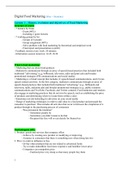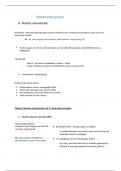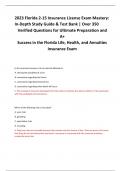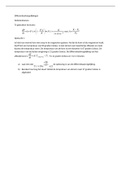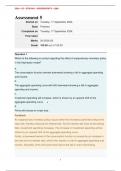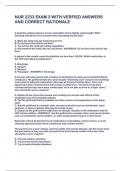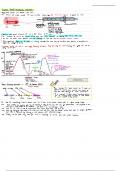Exercises – Chapter 2
Exercise 1 (textbook ex.12)
What is the PV of $100 received in:
a) Year 10 (discount rate = 1%)
!""
PV = !."!!" = €90.53 = €100 x 1.01-10 = €90.53
b) Year 10 (discount rate = 13%)
!""
PV = !.!$!" = €29.46
c) Year 15 (discount rate = 25%)
!""
PV = !.%&!# = €3.52
d) Year 1, 2, and 3 (discount rate = 12%)
!"" !"" !""
PV = !.!%+ !.!%!$ + !.!%!% = €240.18
This is a simple annuity that can be solved using the following formula:
! ! ! !
PV = C x ! − # = €100 x ! − # = €240.18
' ' × (!+')& ".!% ".!%× (! + ".!%)%
Calculator: APPS, Finance, TVM Solver:
PMT = 100 ; N = 3 ; I% = 12 ; FV = 0 → PV = -240.18, so PV = €240.18.1
1
The PV is displayed (or entered) as a negative number. The interpretation of this number is a positive number, however, because
future cash flow streams are positive as well.
1
,Exercise 2
Yasuo Obuchi is 30 and his wage next year is $40.000. He expects a wage increase of 5% per year until his retirement
at age 60.
a) If the opportunity cost is 8%, what is the present value of his total wage?
r = 8%, g = 5%, t = 30 years, C = $40.000 → growing annuity
! !."&%"
→ 𝑃𝑉 = $40,000 !("."-."."&) − ("."-."."&)×!."-%"# = $760,662.53
b) If he saves 5% of his wage each year and invests this at 8% per year, how much will he have saved at age
60?
Future value (FV) of the amount saved and reinvested at age 60? This implies computing the future value of a
growing annuity. We do not have a (straightforward) formula for the FV of such a device, however, only for
the FV of a standard annuity. Solving this problem is possible by first computing the PV of the wage streams
and then the corresponding FV, when invested at 8% per year for 30 years (retirement age 60 years – current
age of 30 years):
→ FV of a growing annuity → intermediate step is needed to calculate this
→ PV of savings = 5% of PV of wage = 5% * $760.662,53 = $38.033,13 (at the age of 30)
→ FV at 60 years old ? Compound the PV to a FV → $38.033,13 * (1,08)30 = $382.714,30
c) If he wants to spend this nest egg in equal amount during the 20 years in retirement, how much can he then
spend each year? Assume an opportunity cost of 8%.
PV at age 60 = $382.714,30
Annual fixed amount (C) = annuity.
! !
PV = C x ! − (!+')& #
' '×
PV at age 60 is known here. This is the amount saved at that age, $382,714.30. The unknown in the formula is
C, the annuity amount:
! !
$382,714.30 = C x !"."- − "."- × (!+"."-)$" #
! !
C = $382,714.30 / !"."- − "."- × (!."-)$" # = $38,980.30
In retirement, Yasuo Obushi can spend $38,980.30 each year for 20 years in order to empty his piggy bank of
$382,714.30.
Calculator: APPS, Finance, TVM Solver:
N = 20 ; I% = 8 ; PV = -382,714.30 ; FV = 0 → PMT 38,980.30
2
,Exercise 3
Amber is 25 and wants to create a nest egg that she can use in retirement at age 65. To this end, she deposits €5,000
per year during 10 years at the start of every year. After she turns 34 she does not make any further deposits.
John is also 25 but likes to postpone thinking about his financial future for some years and enjoy life in the
meantime. Yet, at age 35 he decides to create a nest egg too. Therefore, he deposits €5,000 each year at the start
of the year for 30 years.
Who has saved the most at age 65? Assume an annual return of 8% for both.
Amber:
START → annuity due
Two ways to solve this:
Alternative 1
PV of savings at age 25 = PV of annuity. Here, the exercise indicates that the 10 annual deposits of €5,000 take
place at the start of the year.2 This is known as an annuity due. We can solve this initially as a simple annuity
(with payments at the end of each period) and convert it into an annuity due by multiplying with (1 + r):
! !
PV at age 25 = 5,000 x !"."- − "."-× (!+"."-)!" # = €33,550.41
Conversion into an annuity due value (payments at the start of the year):
PV at age 25 = €33,550.41 x 1.08 = €36,234.44
Calculator: select the option “BEGIN”:
APPS, FINANCE, TVM Solver:
N = 10 ; PMT = 5,000 ; I% = 8 ; FV = 0 ; OPTION = BEGIN → PV = -36,234.44
How much did Amber save at age 65? She will not make any additional deposits after age 34, but the amount
saved will continue to grow at 8% annually. The future value at age 65 becomes: FV = PV x (1 + r)t = 36,234.44
x 1.0840 = €787,175.87
Alternative 2
Solving directly for FV
(!+')& . !
FV = C ! '
#
(!."-)!" . !
FV at age 35 = 5,000 ! # = €72,432.81
"."-
FV at age 65 = €72,432.81 x 1.0830 = €728,866.54 (value as a simple annuity)
FV at age 65, taking into account the context of an annuity due: €728,866.54 x 1.08 = €787,175.87
2
Tip: highlight words like “at the start of the year”, “at the start of each period” …, in the exercise to stress that you are looking
for an annuity due. If the exercise does not indicate the time at which the periodic cash flows take place, you can assume that
they take place at the end of each period, as is the case with a simple annuity or simple perpetuity.
3
, John:
START → annuity due
Two ways to solve this:
Alternative 1
! !
PV at age 35 = 5,000 x ! − # = €56,288.92
"."- "."-× (!."-)%"
Convert into the value of an annuity due (payments at the start of each years) by multiplying with (1 + r):
PV at age 35 = €56,288.92 x 1.08 = €60,792.03
How much did John save by age 65?
FV = PV x (1 + r)t = €60,792.03 x (1.08)30 = €611,729.34
Alternative 2
Solving directly for FV
(!+')& . !
FV = C ! #
'
(!."-)%" . !
FV at age 65 = 5,000 ! "."- # = €566,416.06 (value as a simple annuity)
FV at age 65, taking into account the context of an annuity due: €566,416.06 x 1.08 = €611,729.34
Solution: at age 65 Amber has saved more than John. This illustrates the power of compound interest:
Amber only makes 10 deposits, in contrast to John, who makes 30. However, Amber starts 10 years earlier
than John, and given the return of 8% it still results in a larger final piggy bank at age 65.
4
Exercise 1 (textbook ex.12)
What is the PV of $100 received in:
a) Year 10 (discount rate = 1%)
!""
PV = !."!!" = €90.53 = €100 x 1.01-10 = €90.53
b) Year 10 (discount rate = 13%)
!""
PV = !.!$!" = €29.46
c) Year 15 (discount rate = 25%)
!""
PV = !.%&!# = €3.52
d) Year 1, 2, and 3 (discount rate = 12%)
!"" !"" !""
PV = !.!%+ !.!%!$ + !.!%!% = €240.18
This is a simple annuity that can be solved using the following formula:
! ! ! !
PV = C x ! − # = €100 x ! − # = €240.18
' ' × (!+')& ".!% ".!%× (! + ".!%)%
Calculator: APPS, Finance, TVM Solver:
PMT = 100 ; N = 3 ; I% = 12 ; FV = 0 → PV = -240.18, so PV = €240.18.1
1
The PV is displayed (or entered) as a negative number. The interpretation of this number is a positive number, however, because
future cash flow streams are positive as well.
1
,Exercise 2
Yasuo Obuchi is 30 and his wage next year is $40.000. He expects a wage increase of 5% per year until his retirement
at age 60.
a) If the opportunity cost is 8%, what is the present value of his total wage?
r = 8%, g = 5%, t = 30 years, C = $40.000 → growing annuity
! !."&%"
→ 𝑃𝑉 = $40,000 !("."-."."&) − ("."-."."&)×!."-%"# = $760,662.53
b) If he saves 5% of his wage each year and invests this at 8% per year, how much will he have saved at age
60?
Future value (FV) of the amount saved and reinvested at age 60? This implies computing the future value of a
growing annuity. We do not have a (straightforward) formula for the FV of such a device, however, only for
the FV of a standard annuity. Solving this problem is possible by first computing the PV of the wage streams
and then the corresponding FV, when invested at 8% per year for 30 years (retirement age 60 years – current
age of 30 years):
→ FV of a growing annuity → intermediate step is needed to calculate this
→ PV of savings = 5% of PV of wage = 5% * $760.662,53 = $38.033,13 (at the age of 30)
→ FV at 60 years old ? Compound the PV to a FV → $38.033,13 * (1,08)30 = $382.714,30
c) If he wants to spend this nest egg in equal amount during the 20 years in retirement, how much can he then
spend each year? Assume an opportunity cost of 8%.
PV at age 60 = $382.714,30
Annual fixed amount (C) = annuity.
! !
PV = C x ! − (!+')& #
' '×
PV at age 60 is known here. This is the amount saved at that age, $382,714.30. The unknown in the formula is
C, the annuity amount:
! !
$382,714.30 = C x !"."- − "."- × (!+"."-)$" #
! !
C = $382,714.30 / !"."- − "."- × (!."-)$" # = $38,980.30
In retirement, Yasuo Obushi can spend $38,980.30 each year for 20 years in order to empty his piggy bank of
$382,714.30.
Calculator: APPS, Finance, TVM Solver:
N = 20 ; I% = 8 ; PV = -382,714.30 ; FV = 0 → PMT 38,980.30
2
,Exercise 3
Amber is 25 and wants to create a nest egg that she can use in retirement at age 65. To this end, she deposits €5,000
per year during 10 years at the start of every year. After she turns 34 she does not make any further deposits.
John is also 25 but likes to postpone thinking about his financial future for some years and enjoy life in the
meantime. Yet, at age 35 he decides to create a nest egg too. Therefore, he deposits €5,000 each year at the start
of the year for 30 years.
Who has saved the most at age 65? Assume an annual return of 8% for both.
Amber:
START → annuity due
Two ways to solve this:
Alternative 1
PV of savings at age 25 = PV of annuity. Here, the exercise indicates that the 10 annual deposits of €5,000 take
place at the start of the year.2 This is known as an annuity due. We can solve this initially as a simple annuity
(with payments at the end of each period) and convert it into an annuity due by multiplying with (1 + r):
! !
PV at age 25 = 5,000 x !"."- − "."-× (!+"."-)!" # = €33,550.41
Conversion into an annuity due value (payments at the start of the year):
PV at age 25 = €33,550.41 x 1.08 = €36,234.44
Calculator: select the option “BEGIN”:
APPS, FINANCE, TVM Solver:
N = 10 ; PMT = 5,000 ; I% = 8 ; FV = 0 ; OPTION = BEGIN → PV = -36,234.44
How much did Amber save at age 65? She will not make any additional deposits after age 34, but the amount
saved will continue to grow at 8% annually. The future value at age 65 becomes: FV = PV x (1 + r)t = 36,234.44
x 1.0840 = €787,175.87
Alternative 2
Solving directly for FV
(!+')& . !
FV = C ! '
#
(!."-)!" . !
FV at age 35 = 5,000 ! # = €72,432.81
"."-
FV at age 65 = €72,432.81 x 1.0830 = €728,866.54 (value as a simple annuity)
FV at age 65, taking into account the context of an annuity due: €728,866.54 x 1.08 = €787,175.87
2
Tip: highlight words like “at the start of the year”, “at the start of each period” …, in the exercise to stress that you are looking
for an annuity due. If the exercise does not indicate the time at which the periodic cash flows take place, you can assume that
they take place at the end of each period, as is the case with a simple annuity or simple perpetuity.
3
, John:
START → annuity due
Two ways to solve this:
Alternative 1
! !
PV at age 35 = 5,000 x ! − # = €56,288.92
"."- "."-× (!."-)%"
Convert into the value of an annuity due (payments at the start of each years) by multiplying with (1 + r):
PV at age 35 = €56,288.92 x 1.08 = €60,792.03
How much did John save by age 65?
FV = PV x (1 + r)t = €60,792.03 x (1.08)30 = €611,729.34
Alternative 2
Solving directly for FV
(!+')& . !
FV = C ! #
'
(!."-)%" . !
FV at age 65 = 5,000 ! "."- # = €566,416.06 (value as a simple annuity)
FV at age 65, taking into account the context of an annuity due: €566,416.06 x 1.08 = €611,729.34
Solution: at age 65 Amber has saved more than John. This illustrates the power of compound interest:
Amber only makes 10 deposits, in contrast to John, who makes 30. However, Amber starts 10 years earlier
than John, and given the return of 8% it still results in a larger final piggy bank at age 65.
4

